Building an Orogen: Review of U-Pb Zircon Ages from the Calabria–Peloritani Terrane to Constrain the Timing of the Southern Variscan Belt
Abstract
1. Introduction
2. Geological Framework of the Calabria–Peloritani Terrane
3. Pre-Variscan Ages in the CPT
3.1. Age Distribution in the Castagna Unit
3.2. Age Distribution in the Aspromonte–Peloritani Unit
3.3. Age Distribution in the Lower Complex
3.4. Age Distribution in the Sila–Serre Unit
4. A Synthesis of the Variscan Ages
5. Discussion
5.1. Significance of Proterozoic—Cambrian Signatures
5.2. Significance of Ordovician—Silurian Signatures
5.3. Significance of Devonian Signatures
5.4. From Pre-Variscan to Variscan Geodynamic Frameworks Revealed by Zircon Ages
6. Conclusions
- The age peaks from around 2500 Ma to 1600 Ma and 1000 Ma in the deep–intermediate crustal levels testify that the origin of the CPT was related to fragments of West and East Gondwana realms, respectively.
- The sedimentation age of the considered Cadomian terrane (i.e., the CPT), was around 630 Ma; this terrane was later affected by Ediacaran (579–540 Ma) bimodal (i.e., gabbros and granitoids) intrusions, which induced zircon recrystallization in host metasediments as shown by overgrowths dated 556–509 Ma.
- An Ordovician–Silurian extensional tectonic phase (at around 450 Ma) connected to the incipient opening, northwards, of the Rheic ocean, affected the northern Cadomian terranes inducing fluid-assisted metamorphism in some domains. At the same time on this Cadomian substrate, sedimentation and volcanic to subvolcanic activity took place, forming the protoliths of the future Variscan upper crust.
- Subduction of the Palaeotethys–Gondwana margin beneath Laurussia began around 347 Ma with under-thrusting of the formerly Gondwana substrate, and induced middle- to high-grade metamorphism in this crust. The Ordovician–Silurian sedimentary cover was scraped off along the front of the Southern Variscan Belt and subjected to low-grade metamorphism. After the compressive tectonic phase, decompression of the whole orogenic system occurred around 320 Ma and led to uplifting of the chain with emplacement of huge granitic intrusions and partial melting of the fertile rocks within the deeper crust. The last metamorphic and magmatic stages occurred around 280 Ma, when the southern Variscan orogenic cycle ended.
Supplementary Materials
Author Contributions
Funding
Acknowledgments
Conflicts of Interest
References
- Hoskin, P.W.O.; Schaltegger, U. The composition of zircon and igneous and metamorphic petrogenesis. Zircon 2018, 53, 27–62. [Google Scholar]
- Corfu, F.; Hanchar, J.M.; Hoskin, P.W.O.; Kinny, P. Atlas of zircon textures. Zircon 2003, 53, 469–500. [Google Scholar]
- Nasdala, L.; Zhang, M.; Kempe, U.; Panczer, G.; Gaft, M.; Andrut, M.; Plötze, M. Spectroscopic methods applied to zircon. Zircon 2003, 53, 427–467. [Google Scholar] [CrossRef]
- Griffin, B.; Michael, J.; Joy, D. A Comparison of a Luminescence-based VPSE and an Electron-based GSED for SE and CL Imaging in Variable Pressure SEM with Conventional SE imaging. Microsc. Microanal. 2010, 16. [Google Scholar] [CrossRef][Green Version]
- Gehrels, G. Detrital zircon U-Pb geochronology applied to tectonics. Annu. Rev. Earth Planet. Sci. 2014, 42, 127–149. [Google Scholar] [CrossRef]
- Rubatto, D.; Hermann, J. Experimental zircon/melt and zircon/garnet trace element partitioning and implications for the geochronology of crustal rocks. Chem. Geol. 2007, 241. [Google Scholar] [CrossRef]
- Rubatto, D. Zircon: The Metamorphic Mineral. Rev. Mineral. Geochem. 2017, 83, 261–295. [Google Scholar] [CrossRef]
- Fornelli, A.; Langone, A.; Micheletti, F.; Piccarreta, G. Time and duration of Variscan high-temperature metamorphic processes in the south European Variscides: Constraints from U-Pb chronology and trace element chemistry of zircon. Mineral. Petrol. 2011, 103, 101–122. [Google Scholar] [CrossRef]
- Xia, Q.X.; Zheng, Y.F.; Yuan, H.; Wu, F.Y. Contrasting Lu-Hf and U-Th-Pb isotope systematics between metamorphic growth and recrystallization of zircon from eclogite-facies metagranites in the Dabie orogen, China. Lithos 2009, 112, 477–496. [Google Scholar] [CrossRef]
- Fornelli, A.; Langone, A.; Micheletti, F.; Piccarreta, G. REE partition among zircon, orthopyroxene, amphibole and garnet in a high-grade metabasic system. Geol. Mag. 2018, 155. [Google Scholar] [CrossRef]
- Yakymchuk, C.; Clark, C.; White, R.W. Phase Relations, Reaction Sequences and Petrochronology. Rev. Mineral. Geochem. 2017, 83, 13–53. [Google Scholar] [CrossRef]
- Buick, I.S.; Clark, C.; Rubatto, D.; Hermann, J.; Pandit, M.; Hand, M. Constraints on the Proterozoic evolution of the Aravalli-Delhi Orogenic belt (NW India) from monazite geochronology and mineral trace element geochemistry. Lithos 2010, 120, 511–528. [Google Scholar] [CrossRef]
- Whitehouse, M.J.; Platt, J.P. Dating high-grade metamorphism - Constraints from rare-earth elements in zircon and garnet. Contrib. Mineral. Petrol. 2003, 145. [Google Scholar] [CrossRef]
- Schaltegger, U.; Davies, J.H.F.L. Petrochronology of Zircon and Baddeleyite in Igneous Rocks: Reconstructing Magmatic Processes at High Temporal Resolution. Rev. Mineral. Geochem. 2017, 83, 297–328. [Google Scholar] [CrossRef]
- Zhou, L.G.; Xia, Q.X.; Zheng, Y.F.; Chen, R.X. Multistage growth of garnet in ultrahigh-pressure eclogite during continental collision in the Dabie orogen: Constrained by trace elements and U-Pb ages. Lithos 2011, 127, 101–127. [Google Scholar] [CrossRef]
- Zhang, S.B.; Zheng, Y.F.; Zhao, Z.F. Temperature effect over garnet effect on uptake of trace elements in zircon of TTG-like rocks. Chem. Geol. 2010, 274, 108–125. [Google Scholar] [CrossRef]
- Micheletti, F.; Fornelli, A.; Piccarreta, G.; Tiepolo, M. U-Pb zircon data of Variscan meta-igneous and igneous acidic rocks from an Alpine shear zone in Calabria (southern Italy). Int. J. Earth Sci. 2011, 100, 139–155. [Google Scholar] [CrossRef]
- Malusà, M.G.; Garzanti, E. The Sedimentology of Detrital Thermochronology. In Fission-Track Thermochronology and Its Application to Geology; Springer: Cham, Switzerland, 2019; pp. 123–143. [Google Scholar]
- Mattioli, M.; Lustrino, M.; Ronca, S.; Bianchini, G. Alpine subduction imprint in Apennine volcaniclastic rocks. Geochemical-petrographic constraints and geodynamic implications from Early Oligocene Aveto-Petrignacola Formation (N Italy). Lithos 2012, 134–135, 201–220. [Google Scholar] [CrossRef]
- Lu, G.; Di Capua, A.; Winkler, W.; Rahn, M.; Guillong, M.; von Quadt, A.; Willett, S.D. Restoring the source-to-sink relationships in the Paleogene foreland basins in the Central and Southern Alps (Switzerland, Italy, France): A detrital zircon study approach. Int. J. Earth Sci. 2019, 108, 1817–1834. [Google Scholar] [CrossRef]
- Fornelli, A.; Gallicchio, S.; Micheletti, F.; Langone, A. Preliminary U-Pb Detrital Zircon Ages from Tufiti di Tusa Formation (Lucanian Apennines, Southern Italy): Evidence of Rupelian Volcaniclastic Supply. Minerals 2020, 10, 786. [Google Scholar] [CrossRef]
- Fornelli, A.; Micheletti, F.; Langone, A.; Perrone, V. First U-Pb detrital zircon ages from Numidian sandstones in Southern Apennines (Italy): Evidences of African provenance. Sediment. Geol. 2015, 320. [Google Scholar] [CrossRef]
- Amodio-Morelli, L.; Bonardi, G.; Colonna, V.; Dietrich, D.; Giunta, G.; Ippolito, F.; Liguori, V.; Lorenzoni, S.; Paglionico, A.; Perrone, V.; et al. L’Arco Calabro-Peloritano nell’Orogene Appenninico-Maghrebide. Mem. della Soc. Geol. Ital. 1976, 17, 1–60. [Google Scholar]
- Bonardi, G.; Cavazza, W.; Perrone, V.; Rossi, S. Calabria-Peloritani terrane and northern Ionian Sea. In Anatomy of an Orogen: The Apennines and Adjacent Mediterranean Basins; Springer: Dutch, The Netherlands, 2001; pp. 287–306. [Google Scholar]
- Schenk, V. U-Pb and Rb-Sr radiometric dates and their correlation with metamorphic events in the granulite-facies basement of the serre, Southern Calabria (Italy). Contrib. Mineral. Petrol. 1980, 73, 23–38. [Google Scholar] [CrossRef]
- Piccarreta, G. Deep-rooted overthrusting and blueschistic metamorphism in compressive continental margins. An example from Calabria (Southern Italy). Geol. Mag. 1981, 118, 539–544. [Google Scholar] [CrossRef]
- Rossetti, F.; Faccenna, C.; Goffé, B.; Monié, P.; Argentieri, A.; Funiciello, R.; Mattei, M. Alpine structural and metamorphic signature of the Sila Piccola Massif nappe stack (Calabria, Italy): Insights for the tectonic evolution of the Calabrian Arc. Tectonics 2001, 20, 112–133. [Google Scholar] [CrossRef]
- Langone, A.; Gueguen, E.; Prosser, G.; Caggianelli, A.; Rottura, A. The Curinga-Girifalco fault zone (northern Serre, Calabria) and its significance within the Alpine tectonic evolution of the western Mediterranean. J. Geodyn. 2006, 42, 140–158. [Google Scholar] [CrossRef]
- Pezzino, A.; Angi, G.; Fazio, E.; Fiannacca, P.; Lo Giudice, A.; Ortolano, G.; Punturo, R.; Cirrincione, R.; de Vuono, E. Alpine metamorphism in the aspromonte massif: Implications for a new framework for the southern sector of the Calabria-Peloritani Orogen, Italy. Int. Geol. Rev. 2008, 50, 423–441. [Google Scholar] [CrossRef]
- Heymes, T.; Monié, P.; Arnaud, N.; Pêcher, A.; Bouillin, J.P.; Compagnoni, R. Alpine tectonics in the Calabrian-Peloritan belt (southern Italy): New 40Ar/39Ar data in the Aspromonte Massif area. Lithos 2010, 114, 451–472. [Google Scholar] [CrossRef]
- Ortolano, G.; Visalli, R.; Fazio, E.; Fiannacca, P.; Godard, G.; Pezzino, A.; Punturo, R.; Sacco, V.; Cirrincione, R. Tectono-metamorphic evolution of the Calabria continental lower crust: The case of the Sila Piccola Massif. Int. J. Earth Sci. 2020, 1–25. [Google Scholar] [CrossRef]
- Brandt, S.; Schenk, V. Metamorphic response to Alpine thrusting of a crustal-scale basement nappe in southern Calabria (Italy). J. Petrol. 2020. [Google Scholar] [CrossRef]
- Festa, V.; Cicala, M.; Tursi, F. The Curinga—Girifalco Line in the framework of the tectonic evolution of the remnant Alpine chain in Calabria (southern Italy). Int. J. Earth Sci. 2020. [Google Scholar] [CrossRef]
- Tursi, F.; Bianco, C.; Brogi, A.; Caggianelli, A.; Prosser, G.; Ruggieri, G.; Braschi, E. Cold subduction zone in northern Calabria (Italy) revealed by lawsonite–clinopyroxene blueschists. J. Metamorph. Geol. 2020, 38, 451–469. [Google Scholar] [CrossRef]
- Festa, V.; Messina, A.; Paglionico, A.; Piccarreta, G.; Rottura, A. Pre-Triassic history recorded in the Calabria-Peloritani segment of the Alpine chain, southern Italy. An overview. Period. Mineral. 2004, 73, 57–71. [Google Scholar]
- Dubois, R. Définition d’un socle antéhercynien en Calabre. Comptes rendus l’Académie Sci. Paris 1971, 272, 2052–2055. [Google Scholar]
- Caggianelli, A.; Prosser, G.; Rottura, A. Thermal history vs. fabric anisotropy in granitoids emplaced at different crustal levels: An example from Calabria, Southern Italy. Terra Nova 2000, 12, 109–116. [Google Scholar] [CrossRef]
- Colonna, V.; Lorenzoni, S.; Zanettin Lorenzoni, E. Sull’esistenza di due complessi metamorfici lungo il bordo sud-orientale del massiccio “granitico” delle Serre (Calabria). Boll. della Soc. Geol. Ital. 1973, 92, 801–830. [Google Scholar]
- Borghi, A.; Colonna, V.; Compagnoni, R. Structural and metamorphic evolution of the Bocchigliero and Mandatoriccio complexes in the Sila nappe (Calabrian-Peloritan Arc, Southern Italy). In The Contributions to the Geology of Italy with Special Regards to the Palaeozoic Basements; Carmignani, L., Sassi, F.P., Eds.; IGCP Newsletter: Siena, Italy, 1992; Volume 276, pp. 321–334. [Google Scholar]
- Festa, V.; Caggianelli, A.; Kruhl, J.H.; Liotta, D.; Prosser, G.; Gueguen, E.; Paglionico, A. Late-Hercynian shearing during crystallization of granitoid magmas (Sila massif, southern Italy): Regional implications. Geodin. Acta 2006, 19, 185–195. [Google Scholar] [CrossRef][Green Version]
- Langone, A.; Godard, G.; Prosser, G.; Caggianelli, A.; Rottura, A.; Tiepolo, M. P-T-t path of the Hercynian low-pressure rocks from the Mandatoriccio complex (Sila massif, Calabria, Italy): New insights for crustal evolution. J. Metamorph. Geol. 2010, 28, 137–162. [Google Scholar] [CrossRef]
- Langone, A.; Caggianelli, A.; Festa, V.; Prosser, G. Time Constraints on the Building of the Serre Batholith: Consequences for the Thermal Evolution of the Hercynian Continental Crust Exposed in Calabria (Southern Italy). J. Geol. 2014, 122, 183–199. [Google Scholar] [CrossRef]
- Festa, V.; Caggianelli, A.; Langone, A.; Prosser, G. Time–space relationships among structural and metamorphic aureoles related to granite emplacement: A case study from the Serre Massif (southern Italy). Geol. Mag. 2013, 150, 441–454. [Google Scholar] [CrossRef]
- Festa, V.; Tursi, F.; Caggianelli, A.; Spiess, R. The tectono-magmatic setting of the Hercynian upper continental crust exposed in Calabria (Italy) as revealed by the 1:10,000 structural-geological map of the Levadio stream area. Ital. J. Geosci. 2018, 137, 165–174. [Google Scholar] [CrossRef]
- Tursi, F.; Spiess, R.; Festa, V.; Fregola, R.A. Hercynian subduction-related processes within the metamorphic continental crust in Calabria (southern Italy). J. Metamorph. Geol. 2020, 38, 771–793. [Google Scholar] [CrossRef]
- Angì, G.; Cirrincione, R.; Fazio, E.; Fiannacca, P.; Ortolano, G.; Pezzino, A. Metamorphic evolution of preserved Hercynian crustal section in the Serre Massif (Calabria–Peloritani Orogen, southern Italy). Lithos 2010, 115, 237–262. [Google Scholar] [CrossRef]
- Acquafredda, P.; Barbieri, M.; Lorenzoni, S.; Trudu, C.; Zanettin-Lorenzoni, E. Metamorphism of the Mandatoriccio Unit in the context of the Hercynian and pre-Hercynian evolution of the Calabrian-Peloritani Arc (Southern Italy). Rend. Lincei 1992, 3, 151–161. [Google Scholar]
- Bouillin, J.P.; Majestè-Menjoulas, C.; Baudelot, S.; Cygan, C.; Fournier-Vinas, C.H. Les formations paleozoiques de l’Arc Calabro-Peloritain dans leur cadre structural. Boll. della Soc. Geol. Ital. 1987, 106, 683–698. [Google Scholar]
- Acquafredda, P.; Lorenzoni, S.; Zanettin-Lorenzoni, E. La sequenza Paleozoica dell’Unità di Bocchigliero (Sila, Calabria). Rend. della Soc. Geol. Ital. 1988, 11, 5–22. [Google Scholar]
- Acquafredda, P.; Lorenzoni, S.; Zanettin Lorenzoni, E. Paleozoic sequences and evolution of the Calabrian Peloritani Arc (Southern Italy). Terra Nova 1994, 6, 582–594. [Google Scholar] [CrossRef]
- Navas-Parejo, P.; Rodríguez-Cañero, R.; Martín-Algarra, A.; Somma, R.; Perrone, V. Conodont-based stratigraphy in the Devonian of the Serre Massif (Southern Italy). Stratigraphy 2015, 12, 1–21. [Google Scholar]
- Acquafredda, P.; Lorenzoni, S.; Zanettin Lorenzoni, E.; Barbieri, M.; Trudu, C. The age of volcanism and metamorphism of the Bocchigliero Paleozoic sequence (Sila—Southern Italy). Rend. Lincei 1991, 2, 145–156. [Google Scholar] [CrossRef]
- Colonna, V.; Piccarreta, G. Schema strutturale della Sila Piccola. Boll. della Soc. Geol. Ital. 1975, 94, 3–16. [Google Scholar]
- Paglionico, A.; Piccarreta, G. Le Unità del Fiume Pomo e di Castagna nelle Serre settentrionali (Calabria). Boll. Della Soc. Geol. Ital. 1976, 95, 27–37. [Google Scholar]
- Williams, I.S.; Fiannacca, P.; Cirrincione, R.; Pezzino, A. Peri-Gondwanan origin and early geodynamic history of NE Sicily: A zircon tale from the basement of the Peloritani Mountains. Gondwana Res. 2012, 22, 855–865. [Google Scholar] [CrossRef]
- Cirrincione, R.; Fazio, E.; Fiannacca, P.; Ortolano, G.; Pezzino, A.; Punturo, R. The Calabria-Peloritani Orogen, a composite terrane in Central Mediterranean; Its overall architecture and geodynamic significance for a pre-Alpine scenario around the Tethyan basin. Period. Mineral. 2015, 84, 701–749. [Google Scholar] [CrossRef]
- Crisci, G.M.; Donati, G.; Messina, A.; Russo, S.; Perrone, V. L’Unita’ Superiore dell’Aspromonte. Studio geologico e petrografico. Rend. della Soc. Ital. Mineral. Petrol. 1982, 38, 989–1014. [Google Scholar]
- Graessner, T.; Schenk, V. Low-pressure metamorphism of Palaeozoic pelites in the Aspromonte, southern Calabria: Constraints for the thermal evolution in the Calabrian crustal cross-section during the Hercynian orogeny. J. Metamorph. Geol. 1999, 17, 157–172. [Google Scholar] [CrossRef]
- Bouillin, J.P. Nouvelle interprétation de la liaison Apennin-Maghrébides en Calabre; conséquences sur la paléogéographie téthysienne entre Gibraltar et les Alpes. Rev. Géol. Dyn. Géogr. Phys. 1984, 25, 321–338. [Google Scholar]
- Cirrincione, R.; Fazio, E.; Ortolano, G.; Pezzino, A.; Punturo, R. Fault-related rocks: Deciphering the structural-metamorphic evolution of an accretionary wedge in a collisional belt, NE Sicily. Int. Geol. Rev. 2012, 54, 940–956. [Google Scholar] [CrossRef]
- Fiannacca, P.; Williams, I.S.; Cirrincione, R.; Pezzino, A. The augen gneisses of the Peloritani Mountains (NE Sicily): Granitoid magma production during rapid evolution of the northern Gondwana margin at the end of the Precambrian. Gondwana Res. 2013, 23, 782–796. [Google Scholar] [CrossRef]
- Trombetta, A.; Cirrincione, R.; Corfu, F.; Mazzoleni, P.; Pezzino, A. Mid-Ordovician U-Pb ages of porphyroids in the Peloritan Mountains (NE Sicily): Palaeogeographical implications for the evolution of the Alboran microplate. J. Geol. Soc. 2004, 161, 265–276. [Google Scholar] [CrossRef]
- Cirrincione, R.; Fiannacca, P.; Lo Giudice, A.; Pezzino, A. Evidence of early Palaeozoic continental rifting from mafic metavolcanics of Southern Peloritani Mountains (north-eastern Sicily, Italy). Ofioliti 2005, 30, 15–25. [Google Scholar] [CrossRef]
- Somma, R.; Navas-Parejo, P.; Martín-Algarra, A.; Rodríguez-Cañero, R.; Perrone, V.; Martínez-Pérez, C. Paleozoic stratigraphy of the Longi-Taormina Unit (PeloritanianMountains, southern Italy). Stratigraphy 2013, 10, 127–152. [Google Scholar]
- Fornelli, A.; Micheletti, F.; Piccarreta, G. Late-Proterozoic to Paleozoic history of the peri-Gondwana Calabria–Peloritani Terrane inferred from a review of zircon chronology. SpringerPlus 2016, 5, 1–19. [Google Scholar] [CrossRef] [PubMed]
- Micheletti, F.; Barbey, P.; Fornelli, A.; Piccarreta, G.; Deloule, E. Latest precambrian to early cambrian U-Pb zircon ages of augen gneisses from Calabria (Italy), with inference to the Alboran microplate in the evolution of the peri-Gondwana terranes. Int. J. Earth Sci. 2007, 96, 843–860. [Google Scholar] [CrossRef]
- Fornelli, A.; Piccarreta, G.; Micheletti, F. In situ U-Pb Dating Combined with SEM Imaging on Zircon—An Analytical Bond for Effective Geological Recontructions. In Geochronol.-Methods Case Stud.; Nils-Axel Morner, N.-A., Ed.; IntechOpen: London, UK, 2014. [Google Scholar]
- Vermeesch, P. On the visualisation of detrital age distributions. Chem. Geol. 2012, 312–313, 190–194. [Google Scholar] [CrossRef]
- Micheletti, F.; Fornelli, A.; Piccarreta, G.; Barbey, P.; Tiepolo, M. The basement of Calabria (southern Italy) within the context of the Southern European Variscides: LA-ICP-MS and SIMS U-Pb zircon study. Lithos 2008, 104, 1–11. [Google Scholar] [CrossRef]
- Laurita, S.; Prosser, G.; Rizzo, G.; Langone, A.; Tiepolo, M.; Laurita, A. Geochronological study of zircons from continental crust rocks in the Frido Unit (southern Apennines). Int. J. Earth Sci. 2014, 104, 179–203. [Google Scholar] [CrossRef]
- Langone, A. Metamorfismo Ercinico di Bassa-Pressione: Evoluzione Tettonico-Metamorfica del Complesso di Mandatoriccio (Massiccio della Sila—Calabria). Ph.D Thesis, Alma Mater Studiorum Università di Bologna, Bologna, Italy, 2008. [Google Scholar]
- Langone, A. Hercynian low-pressure metamorphism: Tectono-metamorphic evolution of the Mandatoriccio complex (Sila massif—Calabria). Plinius 2008, 34, 81–89. [Google Scholar]
- Langone, A.; Micheletti, F. Provenance of Hercynian medium-low grade metasediments in northern Calabria (southern Italy): Evidence from LA-ICP-MS U-Pb data of detrital zircons from the Mandatoriccio complex. Rend. Online Soc. Geol. Ital. 2012, 21, 133–135. [Google Scholar]
- Williams, I.S. Response of detrital and zircon and monazite, and their U-Pb isotopic systems, to regional metamorphism and host-rock partial melting, Cooma Complex, Southeastern Australia. Aust. J. Earth Sci. 2001, 48, 557–580. [Google Scholar] [CrossRef]
- Rubatto, D.; Williams, I.S.; Buick, I.S. Zircon and monazite response to prograde metamorphism in the Reynolds Range, central Australia. Contrib. Mineral. Petrol. 2001, 140, 458–468. [Google Scholar] [CrossRef]
- Fornelli, A.; Piccarreta, G.; Del Moro, A.; Acquafredda, P. Multi-stage melting in the lower crust of the Serre (southern Italy). J. Petrol. 2002, 43, 2191–2217. [Google Scholar] [CrossRef]
- Fornelli, A.; Pascazio, A.; Piccarreta, G. Diachronic and different metamorphic evolution in the fossil Variscan lower crust of Calabria. Int. J. Earth Sci. 2011, 101, 1191–1207. [Google Scholar] [CrossRef]
- Festa, V.; Fornelli, A.; Paglionico, A.; Pascazio, A.; Piccarreta, G.; Spiess, R. Asynchronous extension of the late-Hercynian crust in Calabria. Tectonophysics 2012, 518–521, 29–43. [Google Scholar] [CrossRef]
- Fiannacca, P.; Williams, I.S.; Cirrincione, R.; Pezzino, A. Crustal contributions to late hercynian peraluminous magmatism in the Southern Calabria-Peloritani Orogen, Southern Italy: Petrogenetic inferences and the gondwana connection. J. Petrol. 2008, 49, 1497–1514. [Google Scholar] [CrossRef]
- Fiannacca, P.; Basei, M.A.S.; Cirrincione, R.; Pezzino, A.; Russo, D. Water-assisted production of late-orogenic trondhjemites at magmatic and subsolidus conditions. Geol. Soc. Spec. Publ. 2020, 491. [Google Scholar] [CrossRef]
- Fiannacca, P.; Williams, I.S.; Cirrincione, R. Timescales and mechanisms of batholith construction: Constraints from zircon oxygen isotopes and geochronology of the late Variscan Serre Batholith (Calabria, southern Italy). Lithos 2017, 277, 302–314. [Google Scholar] [CrossRef]
- Graessner, T.; Schenk, V.; Brocker, M.; Mezger, K.; Bröcker, M.; Mezger, K. Geochronological constraints on the timing of granitoid magmatism, metamorphism and post-metamorphic cooling in the Hercynian crustal cross-section of Calabria. J. Metamorph. Geol. 2000, 18, 409–421. [Google Scholar] [CrossRef]
- Gasquet, D.; Levresse, G.; Cheilletz, A.; Azizi-Samir, M.R.; Mouttaqi, A. Contribution to a geodynamic reconstruction of the Anti-Atlas (Morocco) during Pan-African times with the emphasis on inversion tectonics and metallogenic activity at the Precambrian-Cambrian transition. Precambrian Res. 2005, 140, 157–182. [Google Scholar] [CrossRef]
- Fiannacca, P.; Williams, I.S.; Cirrincione, R.; Pezzino, A. Poly-orogenic melting of metasedimentary crust from a granite geochemistry and inherited zircon perspective (southern calabria-peloritani orogen, Italy). Front. Earth Sci. 2019, 7, 1–15. [Google Scholar] [CrossRef]
- Díez Fernández, R.; Arenas, R. The Late Devonian Variscan suture of the Iberian Massif: A correlation of high-pressure belts in NW and SW Iberia. Tectonophysics 2015, 654, 96–100. [Google Scholar] [CrossRef]
- Fornelli, A.; Micheletti, F.; Piccarreta, G. The Neoproterozoic-Early Cambrian felsic magmatism in Calabria (Italy): Inferences as to the origin and geodynamic setting. Period. Mineral. 2007, 76, 99–112. [Google Scholar] [CrossRef]
- von Raumer, J.F.; Bussy, F.; Schaltegger, U.; Schulz, B.; Stampfli, G.M. Pre-mesozoic alpine basements-their place in the European paleozoic framework. Bull. Geol. Soc. Am. 2013, 125, 89–108. [Google Scholar] [CrossRef]
- von Raumer, J.F.; Stampfli, G.M.; Arenas, R.; Sánchez Martínez, S. Ediacaran to Cambrian oceanic rocks of the Gondwana margin and their tectonic interpretation. Int. J. Earth Sci. 2015, 104, 1107–1121. [Google Scholar] [CrossRef]
- Sandiford, M.; Powell, R. Deep crustal metamorphism during crustal extension: Modern and ancient examples. Earth Planet. Sci. Lett. 1986, 79, 151–158. [Google Scholar] [CrossRef]
- Clerc, C.; Lahfid, A.; Monié, P.; Lagabrielle, Y.; Chopin, C.; Poujol, M.; Boulvais, P.; Ringenbach, J.C.; Masini, E.; De St Blanquat, M. High-temperature metamorphism during extreme thinning of the continental crust: A reappraisal of the North Pyrenean passive paleomargin. Solid Earth 2015, 6, 643–668. [Google Scholar] [CrossRef]
- Stampfli, G.M.; Hochard, C.; Vérard, C.; Wilhem, C.; vonRaumer, J. The formation of Pangea. Tectonophysics 2013, 593, 1–19. [Google Scholar] [CrossRef]
- Edel, J.B.; Schulmann, K.; Lexa, O.; Lardeaux, J.M. Late Palaeozoic palaeomagnetic and tectonic constraints for amalgamation of Pangea supercontinent in the European Variscan belt. Earth-Sci. Rev. 2018, 177, 589–612. [Google Scholar] [CrossRef]
- Matte, P. The Variscan collage and orogeny (480-290 Ma) and the tectonic definition of the Armorica microplate: A review. Terra Nova 2001, 13, 122–128. [Google Scholar] [CrossRef]
- Murphy, J.B.; Quesada, C.; Gutiérrez-Alonso, G.; Johnston, S.T.; Weil, A. Reconciling competing models for the tectono-stratigraphic zonation of the Variscan orogen in Western Europe. Tectonophysics 2016, 681, 209–219. [Google Scholar] [CrossRef]
- Spiess, R.; Cesare, B.; Mazzoli, C.; Sassi, R.; Sassi, F.P. The crystalline basement of the Adria microplate in the eastern Alps: A review of the palaeostructural evolution from the Neoproterozoic to the Cenozoic. Rend. Lincei 2010, 21, 31–50. [Google Scholar] [CrossRef]
- Stampfli, G.M.; Borel, G.D. A plate tectonic model for the Paleozoic and Mesozoic constrained by dynamic plate boundaries and restored synthetic oceanic isochrons. Earth Planet. Sci. Lett. 2002, 196, 17–33. [Google Scholar] [CrossRef]
- Di Vincenzo, G.; Carosi, R.; Palmieri, R. The Relationship between Tectono-metamorphic Evolution and Argon Isotope Records in White Mica: Constraints from in situ 40Ar-39Ar Laser Analysis of the Variscan Basement of Sardinia. J. Petrol. 2004, 45, 1013–1043. [Google Scholar] [CrossRef]
- Giacomini, F.; Dallai, L.; Carminati, E.; Tiepolo, M.; Ghezzo, C. Exhumation of a Variscan orogenic complex: Insights into the composite granulitic-amphibolitic metamorphic basement of south-east Corsica (France). J. Metamorph. Geol. 2008, 26, 403–436. [Google Scholar] [CrossRef]
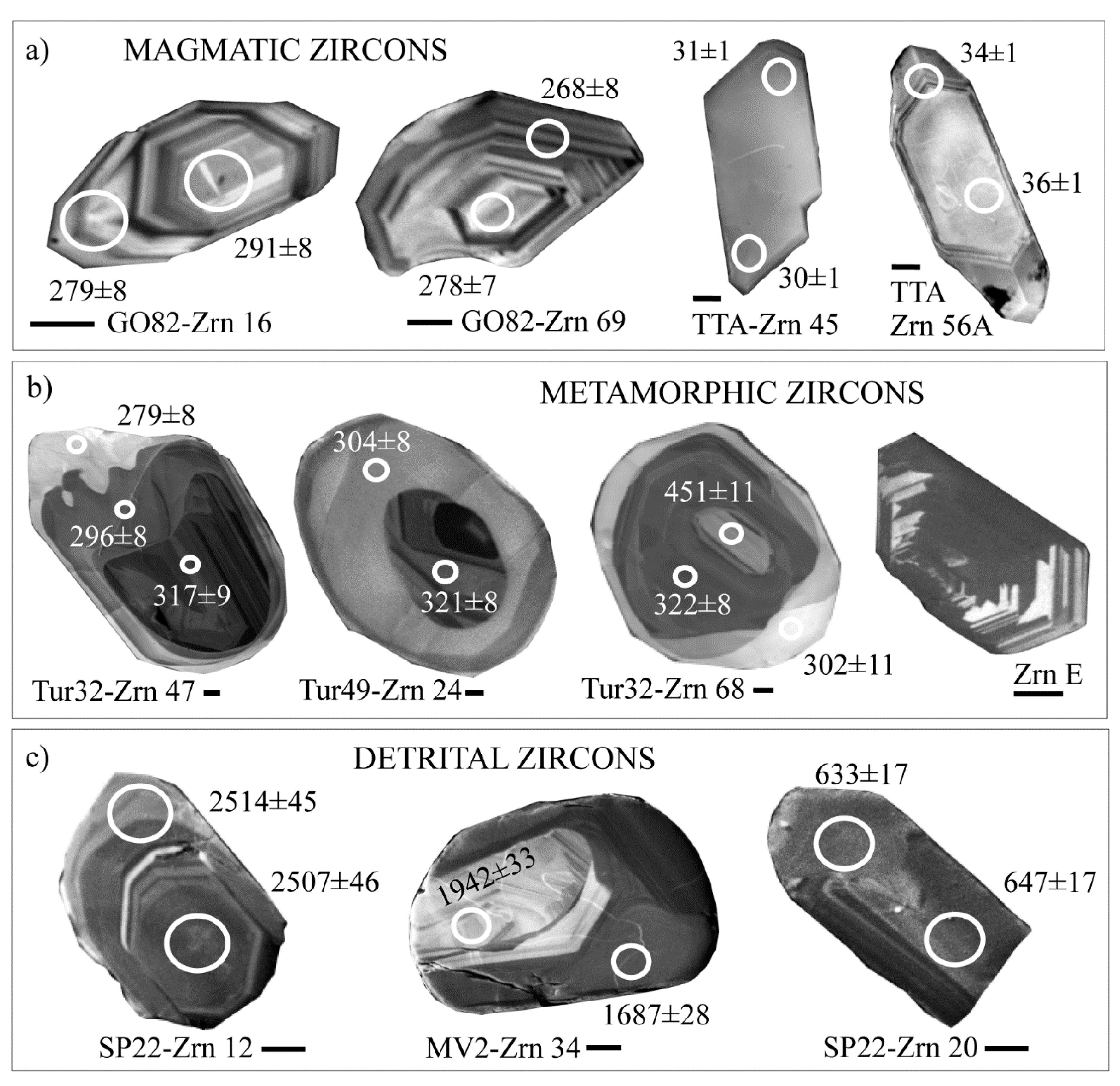
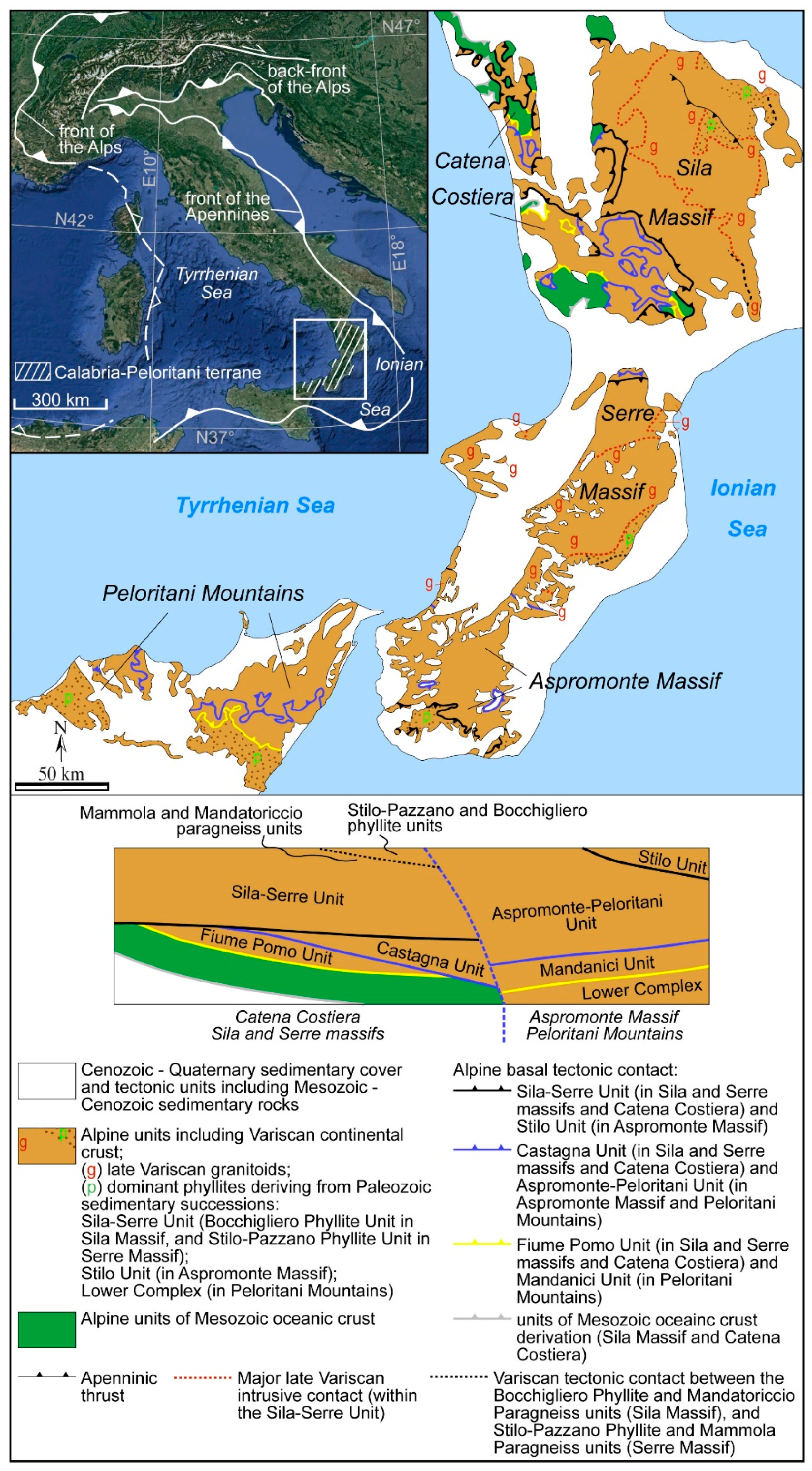
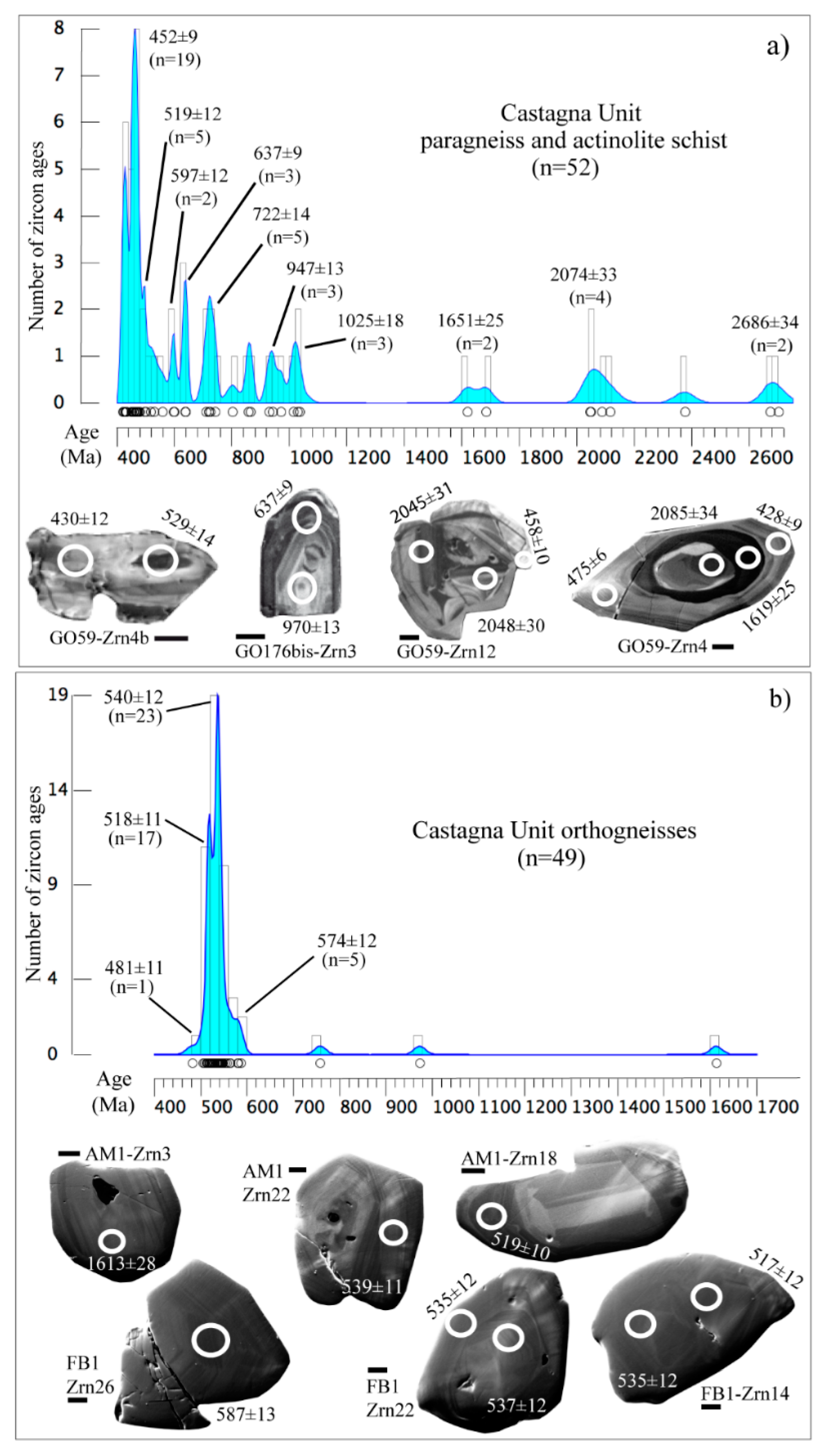
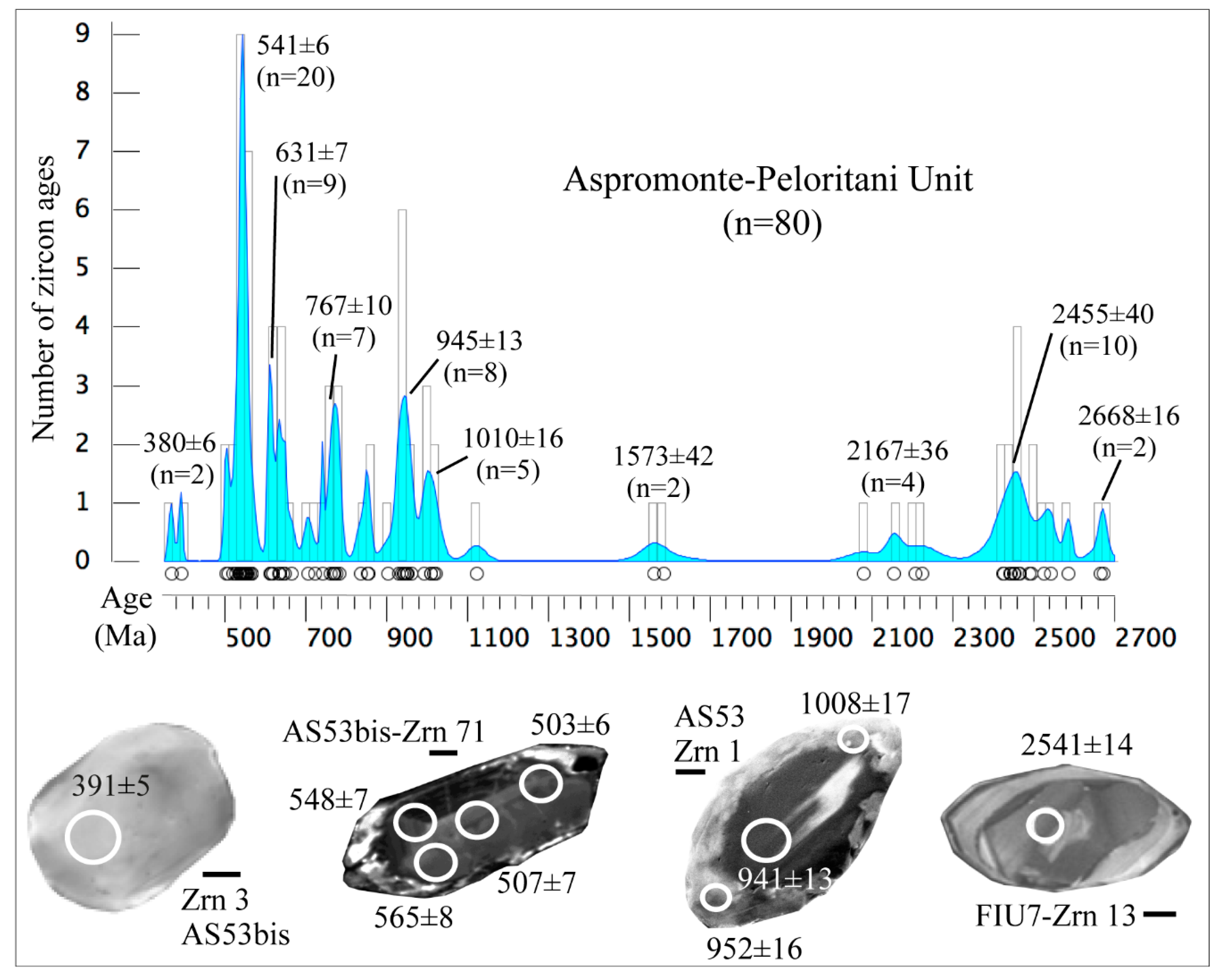
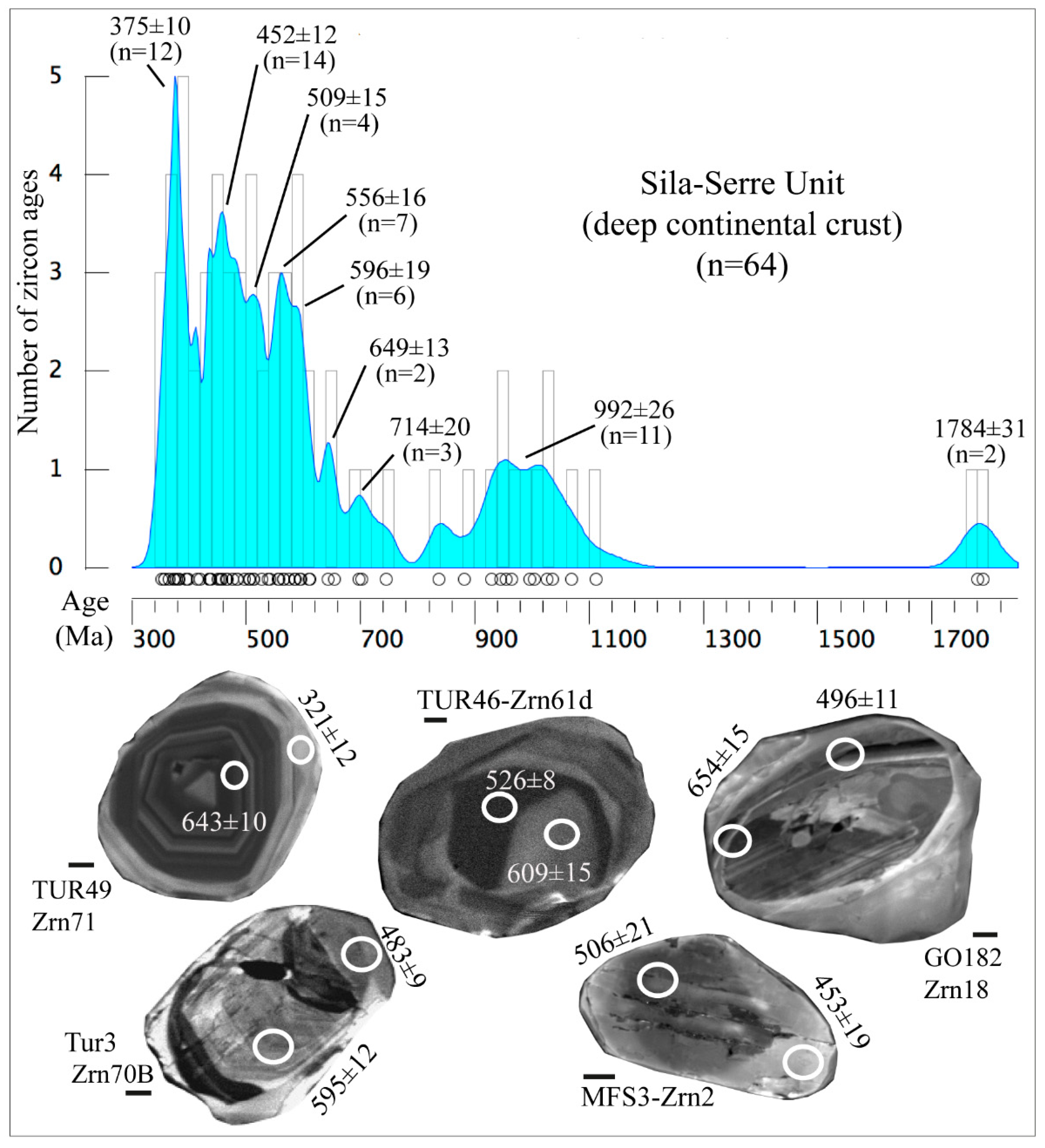
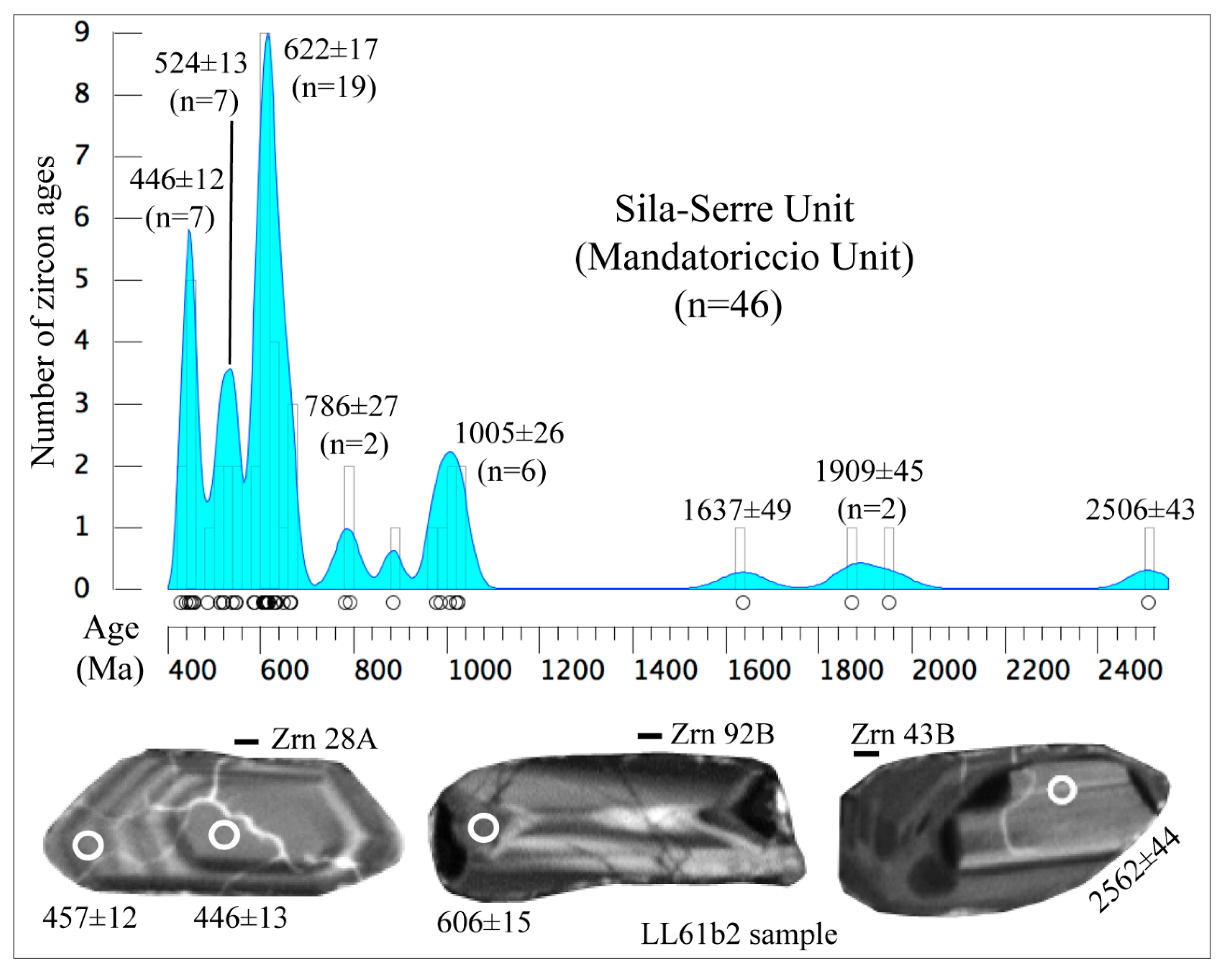

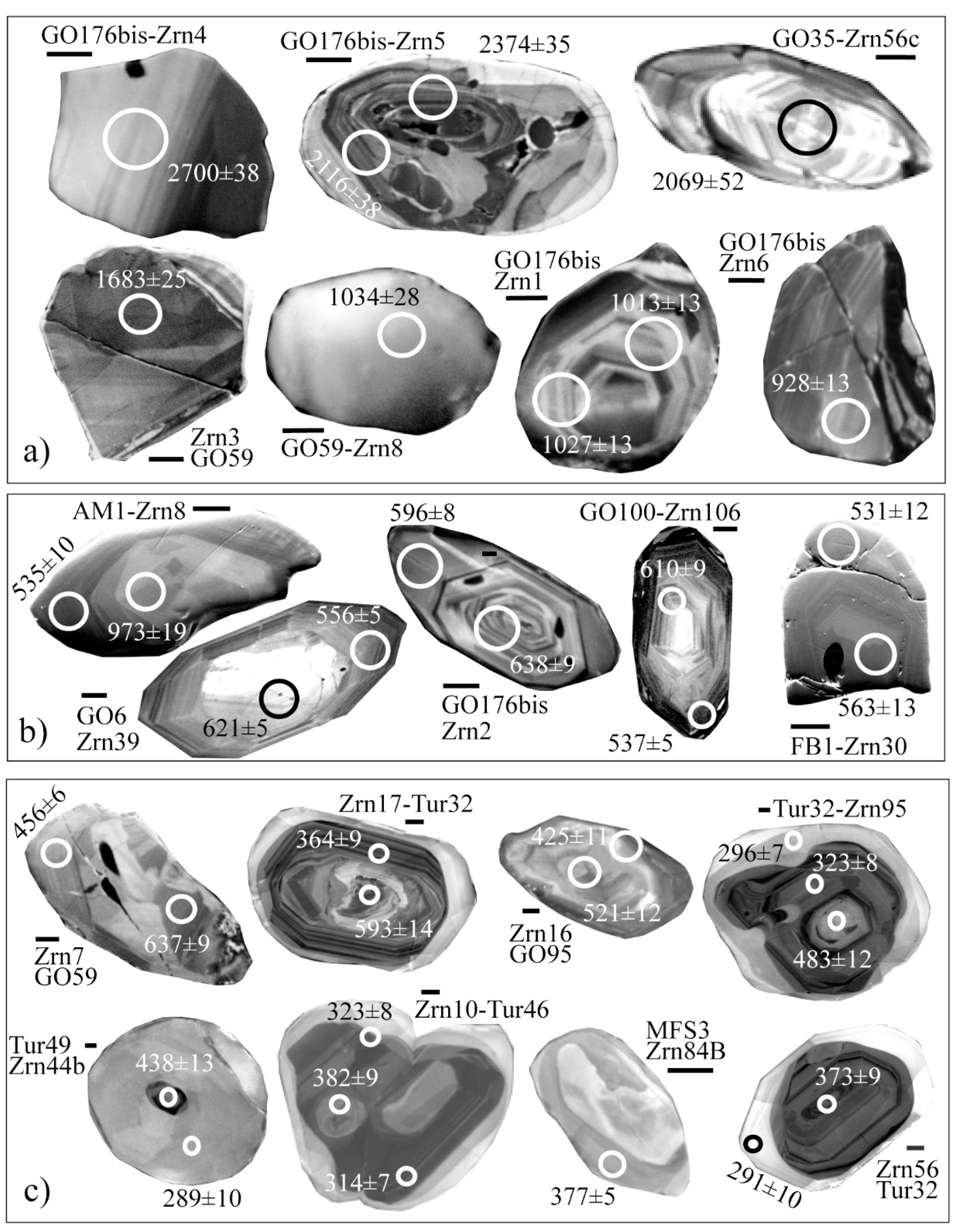
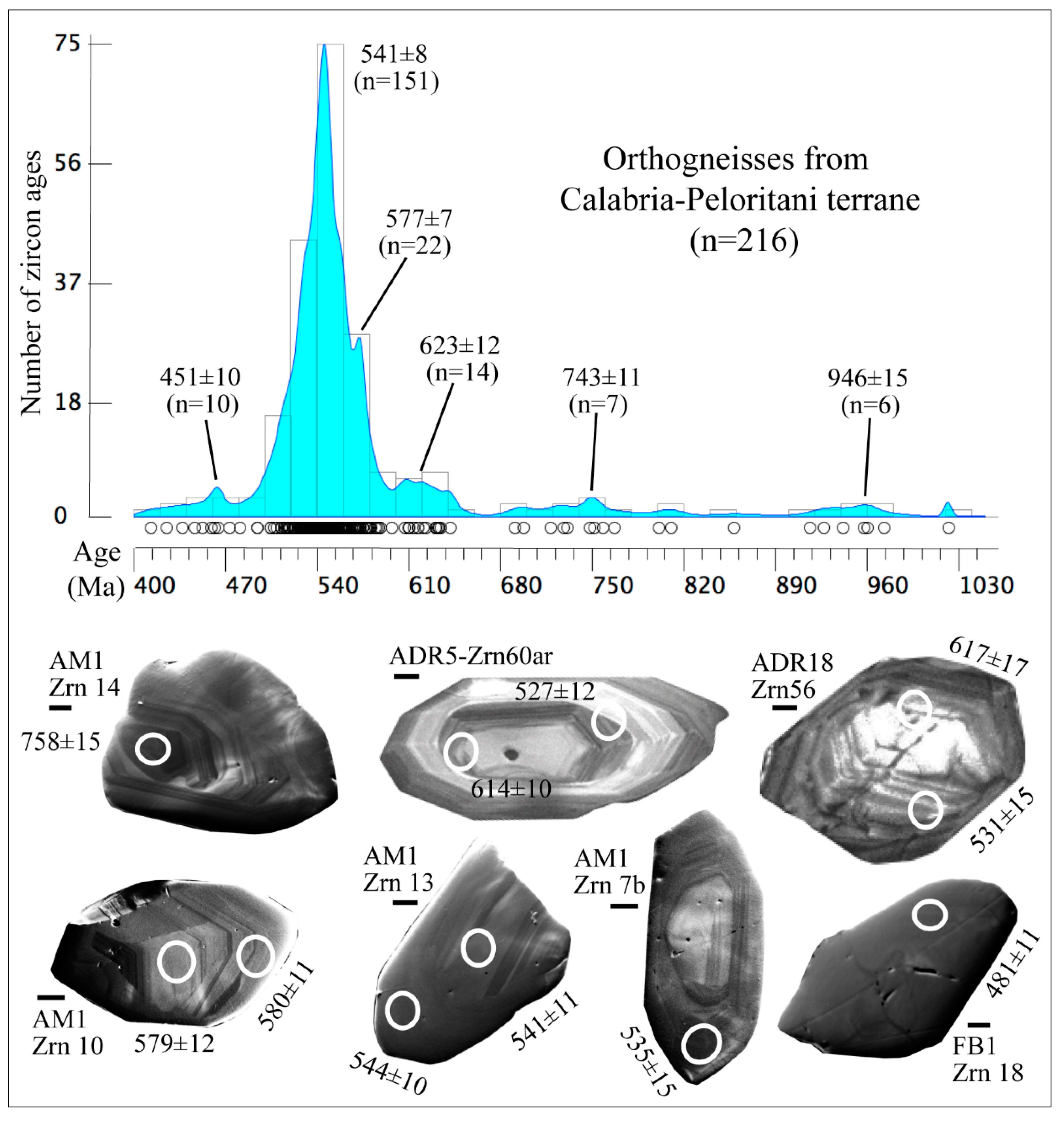
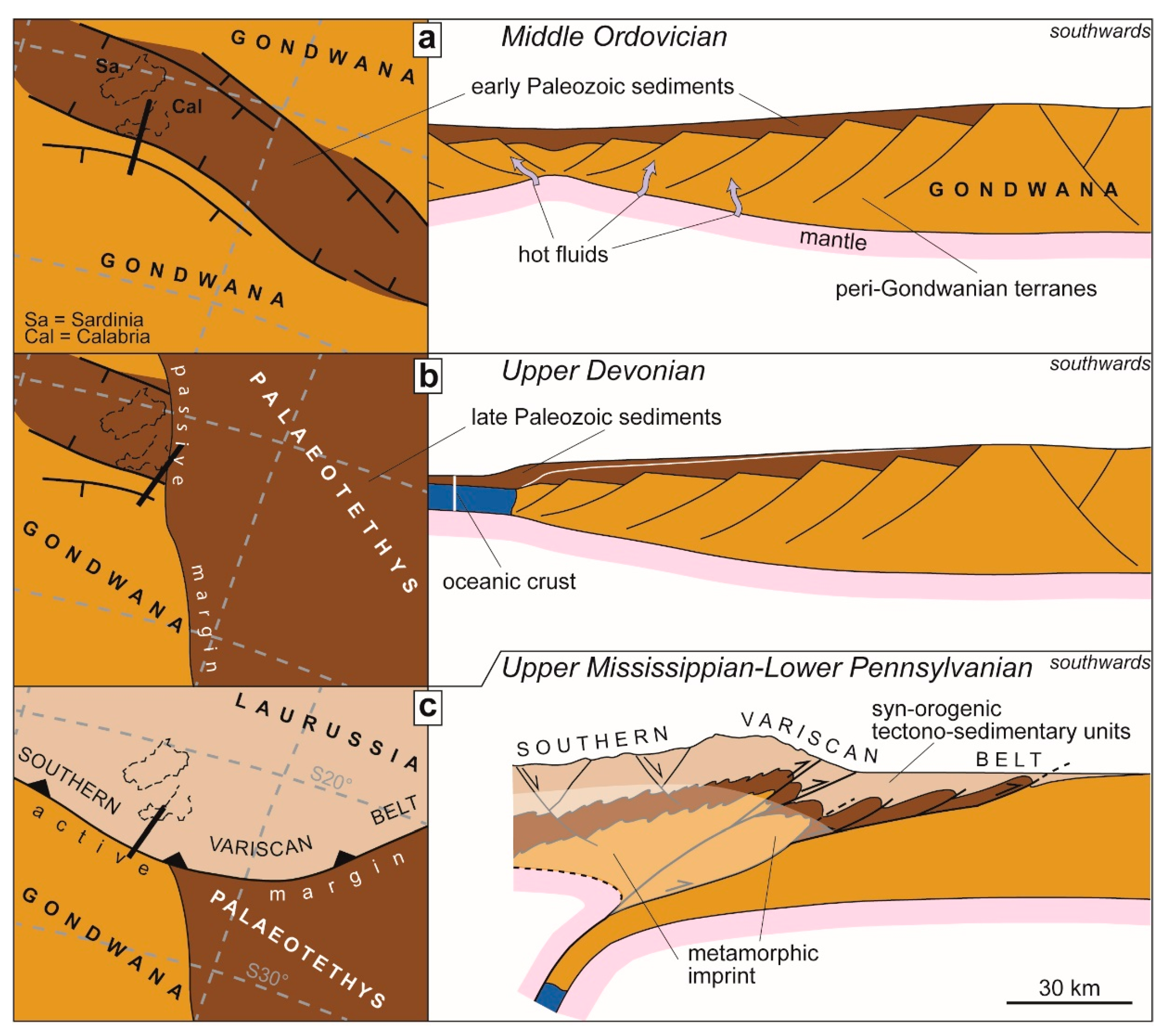
| Castagna Unit (Calabria) | ||||
|---|---|---|---|---|
| Sample & Mineral Assemblage | Ages (Ma) | |||
| Paleo-Proterozoic–Cambrian | Ordovician–Silurian | Devonian | Carboniferous–Permian | |
| GO 59 paragneiss (Sila Massif)—This work (Qtz + Pl + Kfs + Bt ± Ms) | 2059 ± 32 (n = 3), 2085 ± 34, 2048 ± 30, 2045 ± 31, 1683 ± 25, 1619 ± 25, 1034 ± 28, 942 ± 12, 802 ± 21, 718 ± 15 (n = 4), 723 ± 9, 720 ± 17, 719 ± 17, 710 ± 16, 637 ± 9, 599 ± 16, 557 ± 14, 529 ± 14, 517 ± 14, 499 ± 12, 495 ± 6 | 452 ± 9 (n = 19), 478 ± 12–421 ± 6 | ||
| GO 6 augen gneiss (Sila Massif)—[65] (Qtz + Kfs + Pl + Bt ± Ms) | 2216 ± 56, 748 ± 6, 621 ± 5, 585 ± 5, 562 ± 5, 556 ± 5, 544 ± 5 (n = 5), 548 ± 5, 547 ± 4,543 ± 4, 542 ± 5, 541 ± 7, 515 ± 10 | 464 ± 4 | ||
| GO 35 augen gneiss (Sila Massif)—[65] (Qtz + Kfs + Pl + Bt ± Ms) | 2069 ± 52, 588 ± 17, 566 ± 16, 556 ± 16, 552 ± 16, 544 ± 16 | |||
| GO 39 fine-grained leucocratic gneiss (Sila Massif)—[15] (Qtz + Kfs + Pl + Ms ± Bt) | 858 ± 17, 632 ± 15, 631 ± 16, 533 ± 11 (n = 4) | 473 ± 14, 459 ± 10, 413 ± 9 | 302 ± 12, 302 ± 8, 296 ± 9, 294 ± 8, 287 ± 9, 286 ± 7, 285 ± 7, 282 ± 7, 281 ± 7, 275 ± 8, 275 ± 7 (n = 2), 274 ± 8, 265 ± 6, 261 ± 6, 259 ± 11 | |
| GO 95 fine-grained leucocratic gneiss (Sila Massif)—[8] (Qtz + Pl ± Ms ± Kfs ± Bt) | 801 ± 19, 633 ± 14, 547 ± 3 (n = 4), 521 ± 12, 509 ± 14, 504 ± 12, 494 ± 14 | 452 ± 13, 437 ± 10, 425 ± 11 | 259 ± 4 (n = 6), 345 ± 9 | |
| GO 176bis actinolite schist (Catena Costiera Massif)—This work (Qtz + Kfs + Bt + Act ± Chl ± Ser) | 2700 ± 38, 2671 ± 30, 2374 ± 35, 2116 ± 38, 1027 ± 13, 1013 ± 13, 970 ± 13, 928 ± 13, 865 ± 11, 856 ± 12, 741 ± 9, 638 ± 9 (n = 2), 638 ± 9, 637 ± 9, 596 ± 8 | |||
| FB1 augen gneiss (Catena Costiera Massif)—This work (Qtz + Kfs + Pl + Bt ± Ms) | 587 ± 13, 533 ± 12 (n = 21), 563 ± 13 –507 ± 12 | 481 ± 11 | ||
| AM1 augen gneiss (Catena Costiera Massif)—This work (Qtz + Kfs + Pl + Bt ± Ms) | 1613 ± 28, 973 ± 19, 758 ± 15, 580 ± 11 (n = 2), 580 ± 11, 579 ± 12, 531 ± 12 (n = 21), 552 ± 15 –504 ± 10 | |||
| Aspromonte–Peloritani Unit | ||||
| ADR 5 augen gneiss (Aspromonte Massif)—[65] (Qtz + Kfs + Pl + Bt ± Ms) | 917 ± 26, 614 ± 10, 611 ± 11, 597 ± 10, 586 ± 10, 577 ± 10, 568 ± 10, 566 ± 13, 550 ± 16, 527 ± 12 | |||
| ADR 18 augen gneiss (Aspromonte Massif)—[65] (Qtz + Kfs + Pl + Bt ± Ms) | 623 ± 18, 617 ± 17, 565 ± 16, 548 ± 16, 531 ± 15, 526 ± 15, 522 ± 15 | 446 ± 13 | ||
| AS53-AS53bis amphibolite (Aspromonte Massif)—This work (Qtz + Kfs + Pl + Amph) | 2463 ± 51, 2441 ± 50, 2225 ± 43, 2207 ± 45, 2080 ± 39, 1008 ± 17, 952 ± 16, 941 ± 13, 769 ± 10, 761 ± 13, 706 ± 10, 565 ± 8, 548 ± 7, 535 ± 10, 519 ± 9, 507 ± 7, 503 ± 6 | 391 ± 5, 368 ± 6 | ||
| FIU-7 paragneiss (Peloritani Mountains)—[55] (Qtz + Bt + Pl ± Grt ± Sil) | 2668 ± 16 (n = 2), 2672 ± 9, 2664 ± 24, 2551 ± 16 (n = 3), 2586 ± 9, 2541 ± 14, 2525 ± 23, 2456 ± 37 (n = 8), 2493 ± 49–2424 ± 42, 1573 ± 42 (n = 2), 1585 ± 56, 1561 ± 28, 1123 ± 23, 1010 ± 15 (n = 4), 1022 ± 22–993 ± 9, 945 ± 12 (n = 6), 960 ± 12–930 ± 8, 904 ± 17, 855 ± 9, 852 ± 7, 835 ± 10, 768 ± 10 (n = 5), 782 ± 6–741 ± 4, 722 ± 30, 631 ± 7 (n = 9), 664 ± 9–611 ± 6, 546 ± 6 (n = 14), 566 ± 15–527 ± 5 | |||
| FIU-11 augen gneiss (Peloritani Mountains)—[55,60] (Qtz + Kfs + Pl + Bt ± Ms ± Sil) | 3242 ± 13, 2627 ± 25, 2534 ± 27, 1796 ± 35, 1022 ± 3, 958 ± 17, 810 ± 10, 767 ± 15, 728 ± 17, 642 ± 4, 630 ± 6, 610 ± 6, 607 ± 5, 578 ± 10, 545 ± 4 (n = 22), 558 ± 4–516 ± 4 | |||
| MV-15 augen gneiss (Peloritani Mountains)—[55,60] (Kfs + Qtz + Pl + Bt ± Ms) | 2455 ± 9, 2453 ± 39, 2210 ± 22, 1798 ± 30, 960 ± 8, 942 ± 12, 927 ± 10, 731 ± 8, 718 ± 8, 698 ± 8, 691 ± 11, 634 ± 14, 541 ± 5 (n = 25), 557 ± 6–528 ± 7 | |||
| TC-9 augen gneiss (Peloritani Mountains)—[60] (Kfs + Qtz + Pl + Bt) | 581 ± 3–528 ± 4 (n = 35) | |||
| Lower Complex | ||||
| Ta-Pu1-2-3, Ta-Cs, Tao Felsic porphyroids and andesites (Peloritani Mountains)—[61] ID-TIMS data (Qtz + Kfs ± Bt ± Ms ± Chl) | 2013 ± 1, 1140 ± 10 | 450 ± 12 (n = 16), 461 ± 10–432 ± 15 | 401 ± 20, 367 ± 13 | |
| Sila–Serre Unit (deep continental crust) | ||||
| Tur 3 restitic metagreywacke (Serre Massif)—[66] (Grt + Pl + Opx + Amph + Bt) | 483 ± 9 | 325 ± 9, 316 ± 9, 308 ± 9, 297 ± 4 (n = 4), 275 ± 8, 257 ± 7 | ||
| GO 182 migmatitic metapelite (Serre Massif)—[66] (Qtz + Pl + Kfs + Sil + Bt + Grt ± Crd) | 654 ± 15, 1113 ± 10 | 496 ± 11 | 395 ± 9 | 280 ± 2 (n = 18) |
| Tur 17 felsic granulite (Serre Massif)—[66] (Qtz + Pl + Kfs + Grt ± Bt) | 1688 ± 36, 585 ± 9 | 329 ± 14, 286 ± 4 (n = 8), 249 ± 4 | ||
| Tur 76A mafic granulite (Serre Massif)—[67] (Pl + Opx + Grt + Amph + Bt) | 513 ± 9 | 466 ± 15, 436 ± 15, 434 ± 6, 413 ± 6 | 345 ± 4, 298 ± 10, 295 ± 9, 291 ± 6, 285 ± 17, 278 ± 6 | |
| Grt3 mafic granulite (Serre Massif)—[68] (Pl + Grt + Bt + Opx + Qtz + Kfs) | 357 ± 11, 320 ± 10 (n = 8), 334 ± 12–300 ± 9 | |||
| MFS 3 metagabbro (Serre Massif)—[66] (Pl + Amph + Opx + Cpx) | 584 ± 24, 506 ± 21 | 453 ± 19 | 377 ± 5 | 263 ± 8, 231 ± 5, 282 ± 5 (n = 4) |
| Tur 49 meta-quartz-diorite (Serre Massif)—[10] (Pl + Opx + Cpx + Amph) | 744 ± 20, 574 ± 18 | 457 ± 13, 438 ± 13 | 380 ± 11 | 347 ± 3 (n = 10), 319 ± 3 (n = 7), 296 ± 4 (n = 5) |
| Tur 32 metabasite interleaved with felsic granulites (Serre Massif)—[10] (Opx + Pl + Bt) | 593 ± 14, 564 ± 17 | 454 ± 12 (n = 4), 483 ± 12, 464 ± 12, 451 ± 11, 418 ± 14 | 370 ± 6 (n = 3) | 340 ± 7 (n = 2), 321 ± 3 (n = 9), 300 ± 3 (n = 6), 279 ± 8, 277 ± 7, 260 ± 6, 252 ± 8 |
| Tur 46 metabasite interleaved with migmatitic metapelites (Serre Massif)—[10] (Opx + Pl + Bt + Amph) | 609 ± 29, 537 ± 15, 505 ± 11 | 382 ± 9 | 318 ± 5 (n = 2), 303 ± 4 (n = 4), 294 ± 4 (n = 3), 279 ± 10 | |
| GO 100 augen gneiss (Serre Massif)—[65] (Qtz + Kfs + Pl + Bt ± Ms ± Grt ± Sil) | 2502 ± 19, 2404 ± 92, 1760 ± 46, 752 ± 6, 617 ± 23, 575 ± 4, 572 ± 6, 571 ± 4, 552 ± 9, 545 ± 4, 539 ± 7, 537 ± 4, | 494 ± 14, 462 ± 7 | ||
| Garnet-biotite gneiss (northern CPT)—[69] (Pl + Qtz + Grt + Bt) | 1789 ± 31, 1779 ± 31, 1111 ± 44–836 ± 19 (n = 12), 701 ± 24, 696 ± 17, 610 ± 16, 586 ± 17–513 ± 17 (n = 6) | 475 ± 16, 457 ± 12 | 303 ± 8–297 ± 8 (n = 4) 280 ± 11, 255 ± 11 | |
| Sila–Serre Unit (Mandatoriccio Unit) | ||||
| LL61b2 micaschist (Sila Massif)—[70] (Bt + Grt + And + St + Ms ± Crd ± Sil) | 2506 ± 43, 1948 ± 49, 1870 ± 41, 1637 ± 49, 1005 ± 26 (n = 6), 1024 ± 26, 1023 ± 24, 1018 ± 28, 1005 ± 33, 985 ± 28, 977 ± 19, 884 ± 21, 791 ± 25, 780 ± 28, 663 ± 19–585 ± 13, 622 ± 17 (n = 19), 524 ± 13 (n = 7), 547 ± 12–485 ± 13 | 446 ± 12 (n = 7), 457 ± 12–428 ± 10 | ||
| Ages | Castagna Unit | Aspromonte–Peloritani Unit | Lower Complex | Sila–Serre Unit | |
|---|---|---|---|---|---|
| Deep Continental Crust | Mandatoriccio Unit | ||||
| Neo-archean–Paleo-Proterozoic | 2686 ± 34 Ma; 2074 ± 33 Ma; 1651 ± 25 Ma | 2668 ± 16 Ma; 2455 ± 40 Ma; 2167 ± 36 Ma | 2013 ± 1 Ma | 1784 ± 31 Ma | 2506 ± 43 Ma; 1909 ± 45 Ma; 1637 ± 49 Ma |
| Stenian–Tonian | 1025 ± 18 Ma; 947 ± 13 Ma | 1573 ± 42 Ma; 1010 ± 16 Ma; 945 ± 13 Ma | 1140 ± 10 Ma | 992 ± 26 Ma | 1005 ± 26 Ma |
| Cryogenian–Ediacaran | 722 ± 14 Ma; 637 ± 9 Ma | 767 ± 10 Ma; 631 ± 7 Ma | 714 ± 20 Ma 649 ± 13 | 786 ± 27 Ma; 622 ± 17 Ma | |
| Ediacaran–Cambrian | 597 ± 12 Ma; 519 ± 12 Ma | 541 ± 6 Ma | 596 ± 19 Ma; 556 ± 16 Ma 509 ± 15 Ma | 524 ± 13 Ma | |
| Ordovician–Silurian | 452 ± 10 Ma | 461 ± 10 Ma; 432 ± 15 Ma | 452 ± 12 Ma | 446 ± 12Ma | |
| Devonian | 380 ± 6 Ma | 401 ± 20 Ma; 367 ± 13 Ma | 375 ± 10 Ma | ||
Publisher’s Note: MDPI stays neutral with regard to jurisdictional claims in published maps and institutional affiliations. |
© 2020 by the authors. Licensee MDPI, Basel, Switzerland. This article is an open access article distributed under the terms and conditions of the Creative Commons Attribution (CC BY) license (http://creativecommons.org/licenses/by/4.0/).
Share and Cite
Fornelli, A.; Festa, V.; Micheletti, F.; Spiess, R.; Tursi, F. Building an Orogen: Review of U-Pb Zircon Ages from the Calabria–Peloritani Terrane to Constrain the Timing of the Southern Variscan Belt. Minerals 2020, 10, 944. https://doi.org/10.3390/min10110944
Fornelli A, Festa V, Micheletti F, Spiess R, Tursi F. Building an Orogen: Review of U-Pb Zircon Ages from the Calabria–Peloritani Terrane to Constrain the Timing of the Southern Variscan Belt. Minerals. 2020; 10(11):944. https://doi.org/10.3390/min10110944
Chicago/Turabian StyleFornelli, Annamaria, Vincenzo Festa, Francesca Micheletti, Richard Spiess, and Fabrizio Tursi. 2020. "Building an Orogen: Review of U-Pb Zircon Ages from the Calabria–Peloritani Terrane to Constrain the Timing of the Southern Variscan Belt" Minerals 10, no. 11: 944. https://doi.org/10.3390/min10110944
APA StyleFornelli, A., Festa, V., Micheletti, F., Spiess, R., & Tursi, F. (2020). Building an Orogen: Review of U-Pb Zircon Ages from the Calabria–Peloritani Terrane to Constrain the Timing of the Southern Variscan Belt. Minerals, 10(11), 944. https://doi.org/10.3390/min10110944





